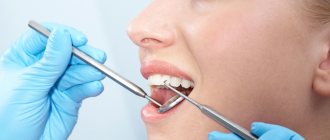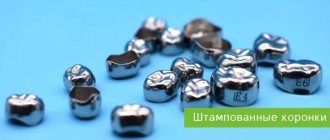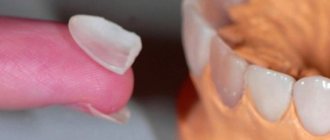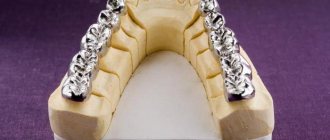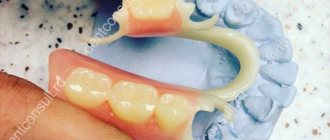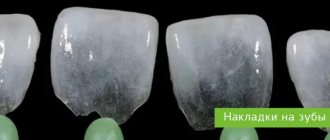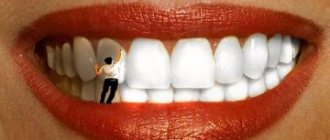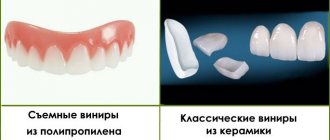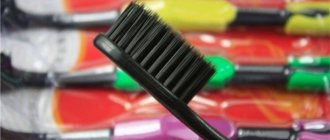- choice of prosthetic technique;
- selection of material for the prosthesis.
The range of materials for dental prosthetics is now wide, which is better? Metal, plastic or ceramics, or maybe a combination of them? In this article we will try to highlight all the features of metal-ceramic prostheses, as well as the pros and cons of the increasingly popular prostheses made of metal-free ceramics.
What is cermet?
When we say “metal-ceramics,” we most often mean crowns and bridges on a metal frame coated with ceramic. Otherwise, it is an orthopedic base made of metal, repeating the shape of a tooth ground for a crown, which is covered on top with a layer of thin ceramics. Ceramic metal is less likely than other materials to cause allergies. Metal-ceramics are used mainly for dental prosthetics in the chewing region, where preference is given not so much to aesthetic qualities as to reliability and functionality.
Why should you contact the 22nd Century Clinic?
The quality and cost of a metal-ceramic crown may vary in different clinics.
The quality and cost of a metal-ceramic crown may vary in different clinics. If the prosthesis is made of high-quality modern materials , then it can really be the best way to restore a lost tooth. If outdated materials and equipment are used, then cermets are unlikely to be a full-fledged replacement; they will quickly collapse.
At the “22 Century” clinic you can install high-quality, durable dentures:
- Professors and researchers with a high level of professionalism and extensive experience work for you;
- We use modern metal alloys and durable porcelain coatings;
- The clinic’s equipment allows us to produce precise metal frames that completely match the shape of the destroyed tooth.
Thanks to this, we have numerous positive reviews from our patients.
Prosthetics with metal-ceramics.
As already noted, metal-ceramics have found their application more in the prosthetics of chewing teeth, where the main thing is strength, not appearance. However, this does not mean that metal ceramics are completely devoid of aesthetics, not at all. The widest range of ceramic coatings allows metal-ceramic crowns to perfectly imitate the shade and structure of natural tooth tissue.
The problem may arise when prosthetics are placed on the front teeth. It is as follows: a dark metal frame can show through a layer of ceramics, that is, the metal simply shines through the translucent coating. Therefore, when replacing anterior teeth, it is most often recommended to use metal-free ceramics or ceramics based on zirconium (zirconium dioxide) - this is, in fact, the same metal ceramics, but the frame material is white metal - zirconium, by the way, is absolutely biocompatible with the human body .
Frequently asked questions about dental prosthetics
We were asked 5 questions about dental prosthetics, check out the full list, and you can also ask your own in a special section of the site - questions
Elena
2018-11-17 15:17:00
Hello! I have had temporary plastic crowns for a year and a half now, 8 teeth on the upper jaw and 5 below. The teeth are all cured, some have inlays. These crowns have already been removed and filed several times, the top one is already broken, they glued it together. The orthopedist is in no hurry to do his job, makes an appointment once every month and a half. About five months ago, I began to experience constant itching and a feeling of fullness in the upper jaw, in the place where the crowns are located. Two months ago, it became painful to press on the gum above one tooth, there was no redness as such, and until recently I had a rash on my wrists and elbows, it went away after taking enterosorbents. I have a general malaise and my lips are constantly dry, maybe it has nothing to do with the problem of my teeth. The doctor himself says that wearing plastic is very harmful and at the same time it’s dragging. the itching was bothering me. I have a question for you, is this an inflammatory process or what could it be? I read that plastic releases a monomer that has a toxic effect. What can be done in my case. Thank you if you don’t ignore my question
Shinberg Oleg Emilievich
chief consultant, orthopedic dentist
Dear Elena, it is indeed very harmful to use temporary plastic crowns made by polymerization for a long time, and indeed, they emit a monomer that is harmful to the gums. Therefore, it is completely incomprehensible to me why your doctor is delaying so long with the manufacture of permanent structures. At a minimum, it is necessary to replace your temporary crowns with temporary crowns made by milling. They do not release monomer, because blanks for milling are made in the factory. Unfortunately, I can’t give any more advice without an examination and consultation, since the cause may not be isolated. In any case, I recommend changing your dentist, because, for some reason, he is clearly not interested in you.
Natalia
2018-10-05 17:02:00
Good afternoon, the 5th tooth is broken, only the root remains. What can be done with it? Or just an implant? Tooth from above
Shinberg Oleg Emilievich
chief consultant, orthopedic dentist
Dear Natalya, in your case there are two options: either tooth extraction followed by implantation and making a crown, or preserving the tooth root and then making a crown. This will depend on the level of the root fracture. Unfortunately, it is impossible to answer the question more accurately without consultation and an x-ray.
Natalia
2017-12-07 18:06:00
Good afternoon I am replacing the upper chewing teeth. It is necessary to place 4 units on teeth 14,15,16,17. The doctor recommends all-ceramic veneers. Initially they planned simple crowns, but today I’m convinced. I doubt it. I read that it is not advisable to put veneers on chewing teeth: they are expensive and less reliable. Is that true? There are no problems with gums or allergies to metal ceramics. The price of a veneer is of course more expensive. Thanks in advance for your answer.
Shinberg Oleg Emilievich
chief consultant, orthopedic dentist
Dear Natalya, good afternoon! The advantage of veneers over crowns is that they require much gentler preparation. Veneers, unlike crowns, do not cover all surfaces of the tooth and the thickness of the walls of the veneer is much thinner than the walls of the crown. As for the reliability and strength of veneers, modern materials make them even more durable and reliable than those on a metal-ceramic crown. Therefore, contraindications for installing veneers on chewing teeth are no longer relevant today. Of course, the price of a veneer is higher than that of metal-ceramic crowns, but the price is compensated by the greater reliability of the veneer and the durability of the structure.
Catherine
2017-11-07 20:52:00
Hello! I would like to know how much it will cost to install ceramic veneers? Thank you.
Shinberg Oleg Emilievich
chief consultant, orthopedic dentist
Good afternoon Ekaterina! The cost of making a ceramic crown (veneer) is 54,000 rubles.
Varvara
After visiting the dentist, it turned out that I would have to have a sinus and implantation of 2 teeth. I'm terribly afraid of the dentist, but I still have to do it. I’ve heard a lot about dental treatment in a dream, but I don’t quite understand how this happens and what the consequences might be after this method of treatment. I would like to consult an experienced specialist on this issue. Tell me if there are any contraindications for carrying out such a procedure and whether you will feel lethargic and drowsy afterwards. I drive all the time, so I want to know if I will be able to drive a car after leaving the office and how will I feel after that?
Shinberg Oleg Emilievich
chief consultant, orthopedic dentist
Dear Varvara, treatment in dreams really does exist, and indeed this method can almost completely relieve stress from people who, like you, are terrified of the dentist. The procedure takes place with the participation of an anesthesiologist and is completely safe. As for the question of being able to get behind the wheel immediately after leaving the office, this is categorically not recommended.
Metal-ceramic prostheses.
What is a metal-ceramic prosthesis upon closer examination? First of all, it is a metal frame covered with a layer of hypoallergenic ceramics. If we compare modern metal-ceramic prostheses with their predecessors made of various composites, we will see the undoubted advantages of metal-ceramics:
- firstly, metal-ceramics reproduces the color and texture of natural tooth tissues quite well;
- secondly, it does not fade, does not absorb dyes and, therefore, does not change color over time;
- thirdly, dental ceramics used in dentures are hypoallergenic and do not cause rejection, except in rare cases;
- and finally, cermets are very durable.
If we are talking about removable dentures made of metal ceramics, then we are talking about a clasp denture. “Bugel” (clasp) means “arc”, and the prosthesis itself is precisely a metal arch with metal-ceramic crowns attached to it. Removable metal-ceramic structures are used when there are contraindications to installing a permanent metal-ceramic prosthesis.
Advantages and disadvantages of metal ceramics.
Patients who decide to have metal-ceramic prosthetics often ask themselves and their doctor the question: can metal-ceramics cause harm?
If the prosthesis is made by professionals from high-quality certified materials in a laboratory in compliance with relevant standards, then the danger of such prosthetics is minimal and practically eliminated. The materials that are used in the manufacture of metal-ceramic crowns are themselves non-toxic, but, nevertheless, they can behave differently in the oral cavity. For example, nickel in frames made of chromium-nickel alloys can cause an allergic reaction. And structures made from base metals can oxidize over time due to a reaction with saliva.
In general terms, the advantages of metal-ceramic prostheses include their durability and strength, while the disadvantages are the need for deeper treatment of the tissues of a living tooth, as well as exposure of the frame when the gums recede and the metal base is visible through the ceramic (the exception is zirconium crowns).
Strength:
Today, metal-ceramic structures are installed mainly on teeth exposed to significant chewing load, although until quite recently they were used everywhere. Metal-free ceramic crowns, on the contrary, did not enjoy increased popularity due to the fragility of their design, and therefore were mainly used to restore front teeth.
But with the advent of zirconium dioxide frames in dentistry, the situation has changed dramatically. An increasing number of both dentists and patients are inclined to use these new materials for prosthetics of both chewing and frontal teeth.
The ultra-strength of cermets also has a downside. Damage occurs to the teeth in contact with the metal-ceramic prosthesis, which can lead to their premature and excessive wear. Whereas the hardness coefficient of ceramic prostheses based on zirconium dioxide is very close to the hardness coefficient of real teeth, therefore, when in contact with a prosthesis made of metal-free ceramics, the opposing teeth are not injured from the impact load.
Allergy:
Allergies in the design of a metal-ceramic prosthesis are caused not by ceramics, which are hypoallergenic, but by the metals used in the frame. Symptoms of an allergy to metal ceramics may include:
- burning sensation in the gums or tongue;
- metallic taste in the mouth;
- swelling and swelling at the site of contact with the crown.
If you experience any of these phenomena after installing a metal-ceramic crown, contact your dentist immediately. If you are allergic to metal-ceramics, there is a way out - this is replacing the metal-ceramic crown with an all-ceramic metal-free orthopedic structure.
Color:
Dental ceramics allow you to choose any color that perfectly matches the natural color of the patient’s teeth. The shade is carefully selected by the dental technician using a special Vita scale.
A metal-ceramic crown will not change color over time and will not fade because it does not absorb pigment at all, unlike composite materials from which fillings are made. For all the above reasons, metal ceramics do not require special bleaching.
Durability:
The main misconception of happy owners of metal-ceramic prostheses is ignoring the service life of such a structure. All patients are confident that it is enough to install a metal-ceramic crown once and for all, and it will serve for the rest of their lives. Let us immediately refute this false statement; it is not true! No matter how regrettable it may be, the service life of any metal-ceramic prosthesis is limited on average from 5 to 12 years.
The key to the longevity of the prosthesis is its high-quality production using individually and precisely made casts, as well as the patient’s compliance with all recommendations for its care when wearing it.
Dental clinics provide a guarantee for metal-ceramics for a period of one to three years, taking into account the frame material and the clinic’s policy. According to the warranty terms, the crown must maintain its integrity and not be subject to destruction under mechanical influence for a certain period specified in the warranty. The crown may last the stated time, however, remember that the most “popular” reason for the crown to fall out is not its damage, but secondary caries that has developed under the crown. To avoid this situation, do not neglect regular preventive examinations and do not delay replacing worn-out orthopedic structures with new ones.
Ceramic metal, like any other material, has a service life, after which the product made from it wears out and becomes unusable, as it cannot fully perform its functions. Ignoring the service life of metal-ceramic dentures can lead to tooth loss!
The procedure for making crown structures for teeth made of metal-ceramics
- Before proceeding with crown modeling, the client is prescribed a series of laboratory examinations. To install a prosthesis, the patient's oral cavity must be completely healthy. Found open cavities are filled and professional cleaning is prescribed.
- Based on the results of the preparatory period, you can begin selecting the product. Some are known for their durability, while others come with more than a year's warranty.
- The production of the prosthesis is carried out in laboratory conditions in stages.
- To obtain a high-quality impression, the doctor carries out a procedure for preparing the supporting part of the chewing element. After which you can make a two-layer print. Then, permanent fixations or bridges are installed in place of the prepared teeth. The dentist must determine the center of closure of the dental system.
- The one-piece metal crown frame is precisely adjusted to size, and the ceramic veneer is selected to match the color of the patient’s teeth.
Metal ceramics VS Ceramics.
If you have indications for prosthetics with a “bridge” or crowns, it is logical that you will begin to ask the question “What is better to install: metal-ceramics or ceramics?”
So, how are they different? Metal-based ceramics and metal-free ceramics will differ in their aesthetic properties, functionality and, of course, price. Of course, a metal-ceramic prosthesis is durable, incomparable to the strength of an all-ceramic one, but it is not always appropriate for prosthetics in the smile area. In this regard, if we are talking about the restoration of the frontal dentition, then in all respects prostheses made of metal-free ceramics win. Therefore, metal-free crowns for the front teeth certainly have superior aesthetic properties.
However, prices for all-ceramic dentures are higher. Therefore, if you want to restore teeth in the chewing section, affordable metal-ceramics will be very acceptable there - it has the necessary strength, and aesthetic defects are unlikely to be visible in the lateral sections.
What are dental crowns?
Dental crowns are special structures that are placed over a tooth for protection and support. A crown can protect an injured or damaged tooth or restore its aesthetic appearance.
Crowns are made from various materials, in particular, based on an alloy of nickel, cobalt and chromium. The prosthesis itself is a metal structure coated with a thin layer of ceramic.
The production of crowns consists of several stages. First, the dentist creates an impression of the future design, after which it is transferred to the dental technician for work. The specialist creates a model of the future crown or crowns, and the doctor tries it on for the patient.
If any shortcomings arise during fitting, the model is sent for revision. If the crown fits perfectly, a ceramic layer is applied over the frame (by casting or spraying), and finally a layer of glaze is applied.
It is important to know that when creating metal-ceramic prostheses, only hypoallergenic materials are used. Only in rare cases can their individual intolerance manifest themselves.
Metal ceramics VS Metal.
All-metal crowns compare favorably with metal-ceramics in price and are not inferior in structural strength. But there are a few “buts”:
- metal can imitate a natural tooth only in terms of anatomical shape (the “iron teeth” effect);
- metal teeth destroy the teeth they come into contact with, increasing their
Metal ceramics VS Zirconium dioxide.
frame of metal-ceramic crowns
crown frame based on zirconium dioxide
We have already explained the differences between metal ceramics and ceramics based on zirconium dioxide. In principle, zirconium is the same metal, which is favorably distinguished by its aesthetic properties (white color) and absolute biocompatibility, but is less favorably distinguished by its price. When choosing a material for dental prosthetics in the smile area, it would be logical to give preference to crowns on a zirconium frame. When restoring chewing teeth, it will be cheaper to install metal ceramics. If the patient has metal intolerance, the solution would be to install a prosthesis on a zirconium frame.
How to install metal ceramics?
Installation of metal ceramics occurs in several stages. First, the patient needs to undergo a general examination, diagnostics and dental treatment, if necessary.
After this, the teeth are prepared for a crown: the enamel is ground down, the nerve is removed (if the condition of the supporting teeth is good, the doctor can leave them alive).
Impressions are taken from the ground teeth, from which individual orthopedic structures are made in the laboratory. Thus, the production and installation of metal-ceramic prostheses takes on average about two weeks.
Keep in mind that grinding for an all-ceramic crown is more gentle, this is due to the thickness of the crown itself (a ceramic crown is thinner). Usually the tooth is not ground down completely; a ledge is formed at the border with the gum, which does not allow the metal frame to come into contact with the gum and, thus, reduces the risks of developing allergies, tissue irritation, bleeding gums and swelling.
The procedure for installing a crown on a metal-ceramic tooth
After the preparatory procedures, the tooth must be sharpened to the size of the crown. An orthopedic dentist takes an impression to form a model of the prosthesis. The actual production of the crown is performed by a dental technician in a dental laboratory.
Typically, a crown on a tooth takes time to produce. Before receiving a permanent prosthesis, the client must visit a specialist at least three times. The duration of the entire process is from seven to ten days, not taking into account the treatment time.
While the permanent crowns are being made, the client will have a temporary plastic crown installed. This is necessary to protect the implant or ground tooth from the influence of food and saliva.
After trying on the finished product, if the patient is comfortable with the prosthesis, it is attached to the implant using a special solution.
Making a crown for a tooth from metal-ceramics
How to properly care for metal-ceramic dentures?
There is nothing supernatural in caring for metal-ceramic structures. It is necessary to brush your teeth morning and evening. No special brushes or cleaning equipment are required. A regular toothbrush will work fine. The main thing is not how to clean it, but how! Pay attention to the movements when cleaning: they should be sweeping, that is, directed from the gums to the edge. If, however, we talk about any specific devices recommended for cleaning metal-ceramic dentures, use dental floss and an irrigator.
If you have the feeling that a tooth or teeth under metal-ceramics hurt or ache, consult a doctor immediately, as pain may be a symptom of secondary caries that has developed under the crown.
In some cases, restoration of a metal-ceramic orthopedic structure may be required. For example, if metal ceramics break off right in the mouth. If the metal frame is not exposed, then most likely the chip is minor and can be restored using composite materials in the oral cavity. Unfortunately, if the frame of the prosthesis is exposed, then reconstruction is impossible. Most likely, you will need to remove the damaged metal-ceramic prosthesis and install a new one in its place. Remember about the service life of metal-ceramics; replacing them in a timely manner will help avoid problems and save the tooth.
Frame making methods
There are several methods for manufacturing metal-ceramic prostheses, the most common of which are casting and milling.
Casting
The first method, casting, is the most ancient, so to speak, and is still used today. It was with him, in fact, that the production of metal-ceramic prostheses began.
It consists in the fact that first the dental technician models the future prosthesis from wax, then packs it into a special device - an oven, where the wax is replaced with metal, which is first melted and flows into liquid form in place of the wax. The metal is cooled, processed, and veneering ceramics are applied to it.
The materials used change, the furnaces are improved, but the essence of the method does not change, although its inherent disadvantages remain, in particular, the non-absolute accuracy of the fit of the frame to the tooth.
The fact is that during the transition from a liquid to a solid state, the metal undergoes shrinkage, which is uneven in different areas of the structure. As a result, on the one hand, gaps can form between the crown and the tooth, where infection can penetrate, and on the other hand, stresses arise in the prosthesis, which contribute to chipping of the ceramic veneer. Therefore, according to statistics, the probability of ceramic chips in metal-ceramic prostheses significantly exceeds this figure in metal-free crowns and bridges.
Milling
The next common method for making frames is milling. This is a completely different level of quality, possible thanks to the widespread introduction of computer technology into dental practice.
The essence of the method is that the frames are not cast, but are cut out from factory blanks based on a computer model, which is created by a dental technician instead of a wax model, as is the case with casting.
The entire manufacturing process is as follows: first, a plaster model is scanned, then a computer model is built. After this, the data is transferred to the milling machine, where the milling process takes place. Simply put, the most modern metal-ceramic structures are manufactured today using a 3-D printer.
Such technologies today make it possible to raise the quality of metal-ceramics to previously unprecedented heights in terms of the accuracy of the fit of the crown to the tooth or implant, which helps to significantly extend the service life of orthopedic structures and supporting teeth or implants.

